ISSN ONLINE(2319-8753)PRINT(2347-6710)
ISSN ONLINE(2319-8753)PRINT(2347-6710)
R.Ganesh1,R.Senthil Kumar 2,K.Kaviya3
|
| Related article at Pubmed, Scholar Google |
Visit for more related articles at International Journal of Innovative Research in Science, Engineering and Technology
The aim of this paper is to propose a control method for a doubly-fed induction generator used in wind energy conversion systems. The proposed control algorithm is applied to a doubly fed induction generator (DFIG) whose stator is directly connected to the grid and the rotor is connected to the grid through a back-to-back AC-DC-AC PWM converters. The control of the rotor-side converter is realized by stator flux oriented control and the fuzzy controller performs robust speed control. The grid side converter (GSC) is controlled in such a way to guarantee a smooth DC voltage and ensure sinusoidal current in the grid side. The results obtained from a system using the proposed fuzzy controller show more accurate control performance and faster dynamic response with almost no steady state error when compared to a system using conventional PI controller.
Keywords |
| Doubly Fed Induction Generator (DFIG), Fuzzy Logic Controller, Field Oriented Controller, Power Converters. |
INTRODUCTION |
| Wind energy can meet the growing energy needs of mankind due to its clean and inexhaustible nature. Wind power generation has developed fast because of commercial application and large-scale development future. In recent years, wind power generation connected to grid has become the mainstream, which gets the support of large grid. The VSCF DFIG wind power generation has many advantages such as variable speed generation, four -quadrant power flow control, good power quality and small converter capacity so that it has become the most widely used wind generator at MW rated. In AC-excited wind generation system, the stator is directly connected to grid. The rotor is indirectly connected to grid by dual PWM converters which are able to regulate the frequency, amplitude and phase angle of rotor current based on the stator flux-oriented vector control strategy. |
| So far, a lot of researches concentrate on rotor current and speed controllers. Typical PI regulator is used most which can satisfy the control requirement under the normal operation conditions. However, system performance will fall down when severe disturbance happens, such as voltage dip or swell. In recent years, fuzzy control has been widely applied to power electronics system. Fuzzy control is applied to control DFIG in the paper [1]. Another PI regulator is used to control the grid side converter (GSC) by using the oriented voltage control strategy. The aim of controlling the GSC is to guarantee a smooth DC voltage and ensure sinusoidal currents in the grid side. The complete system modelling and simulation results show that system has fast dynamic response and good stability. The simulation results are highly consistent with the theoretical analysis. The scheme of the wind energy conversion system (WECS) is presented in Fig.1. |
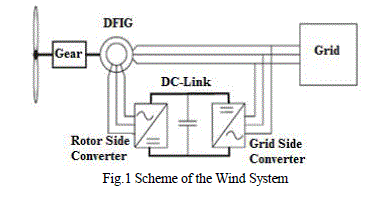 |
| Fig.1 Scheme of the Wind System |
WIND TURBINE MODEL AND FIELD ORIENTED CONTROL OF DFIG |
| A. Turbine Model |
| Wind turbines convert the kinetic energy present in the wind into mechanical energy by means of producing torque. The power coefficient, Cp gives the fraction of the kinetic energy that is converted into mechanical energy by the wind turbine. It is a function of the tip speed ratio (λ) and also depends on the blade pitch angle (θ) for pitch controlled turbines. The mechanical power captured by the turbine from the wind is given by the following expression [2]. |
 |
 |
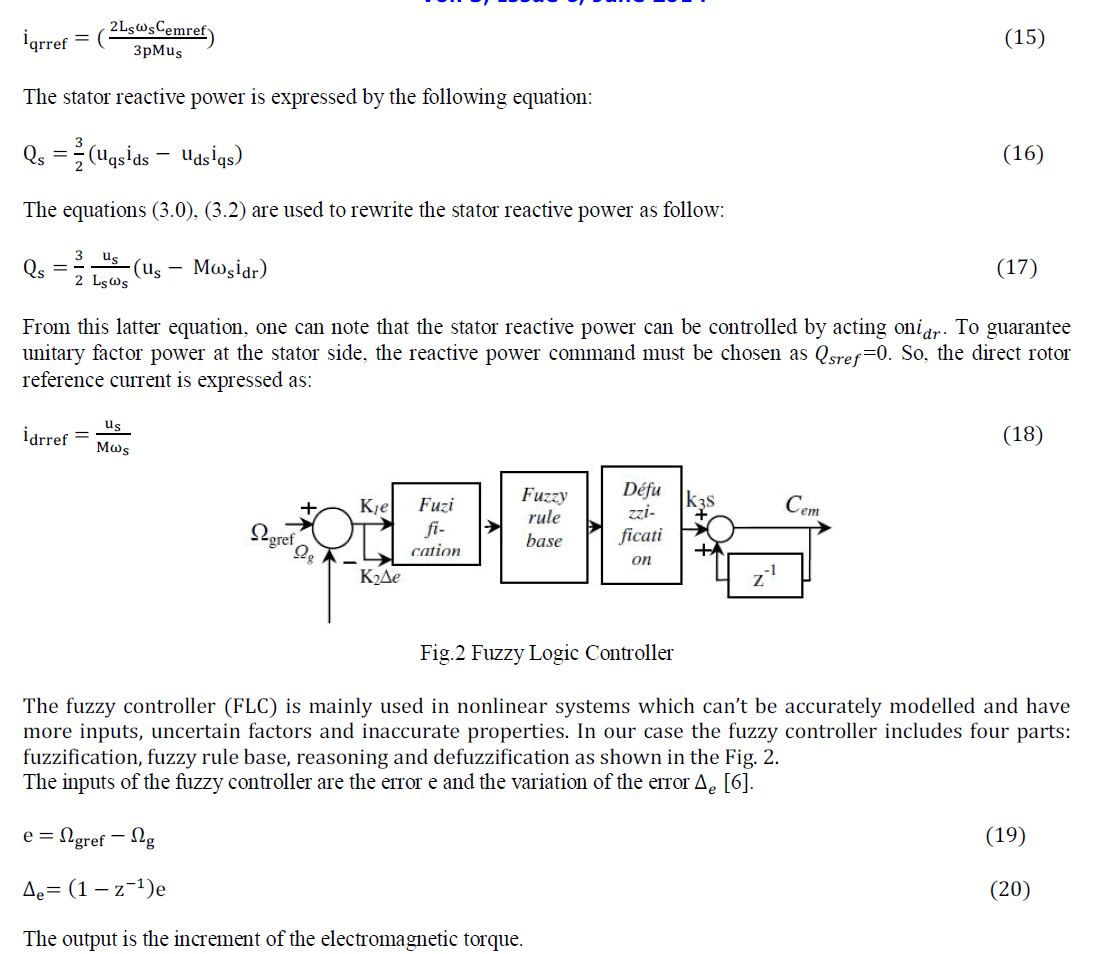 |
 |
| Fig.3 Block Diagram of the Rotor Side Converter Control |
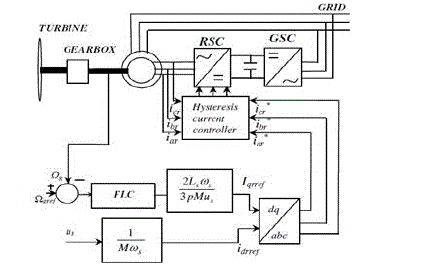 |
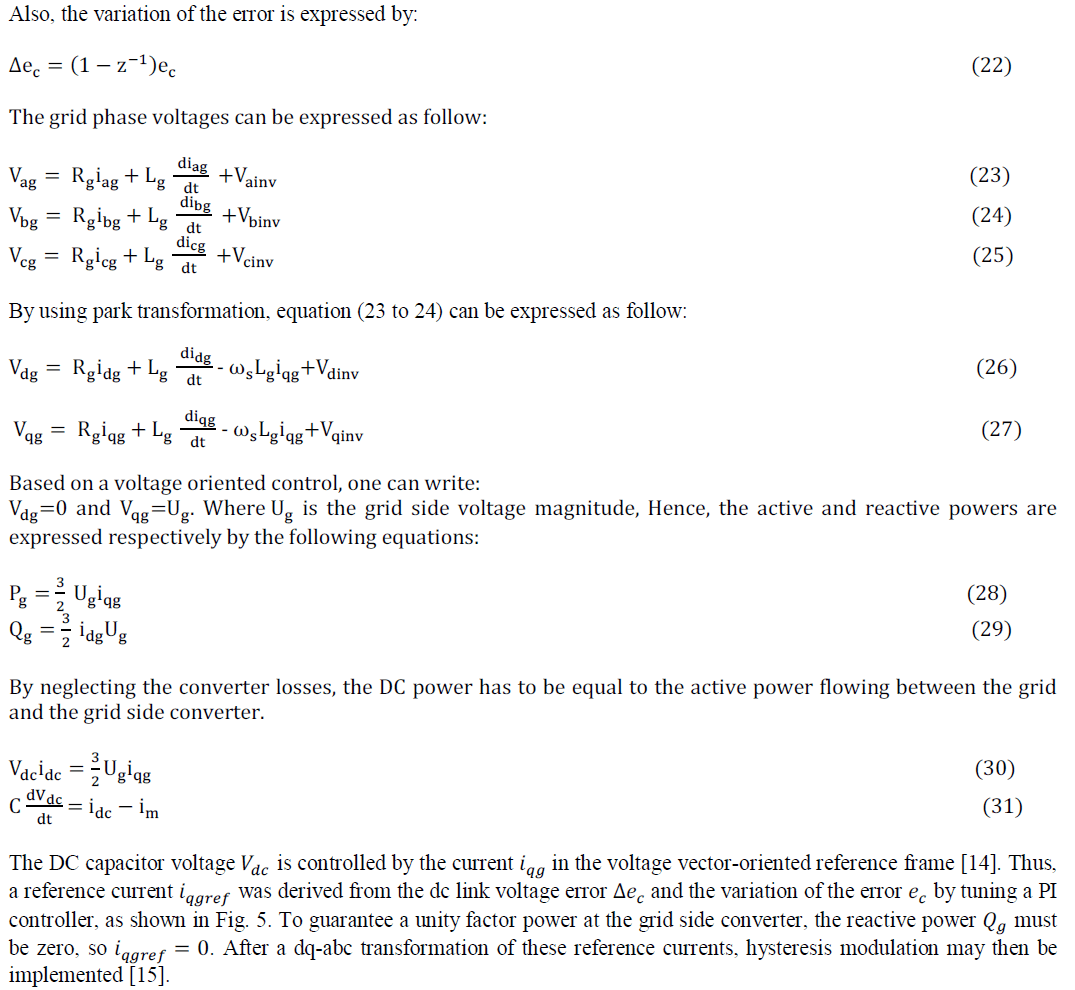 |
FUZZY LOGIC CONTROL |
| E. Fuzzy Controller Design |
| Although PI controller can play an important role in stability of the power system and especially for damping of interarea oscillation, the best performance of the PI controller and accordingly, the performance of the DFIG depend on a suitable choice of the PI gains. Tuning the PI gains to make optimal operation is difficult task, especially, when the process is nonlinear and may change during operation. Because of the fuzzy control robustness about to many nonlinear procedures, this paper suggests the design of the fuzzy controller to control the reactive power modulation [8]. Fuzzy controller introduces a systematic method to control a nonlinear procedure based on human experience. The fuzzy controller operation is based on its capability to simulate several role implications at the same time procedure, and the output results are significantly comprehensive. |
| A correctly designed fuzzy controller can provide higher operation in presence of variations in parameters, external perturbations, and load existence than conventional PI controllers. The basic formation of a fuzzy controller is consisted of four parts: fuzzifications block, fuzzy knowledge based block, a fuzzy inference engine and defuzzification block. Fig. 5 shows the block diagram of the fuzzy control for Δω or Δα. |
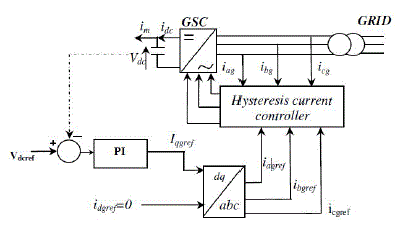 |
| Fig.5 Block Diagram of the Fuzzy Controller |
| Standard triangular membership’s functions were employed for the inputs and output fuzzy sets of the fuzzy controller. The schemed fuzzy sets for Δω or Δα are shown in Fig.5. The control roles of the fuzzy controllers are demonstrated by set of heuristically selected fuzzy rules [9]. The schemed fuzzy rules employed in this paper for controller are stated in Table 1. |
| Table 1. The Fuzzy Rule Bases |
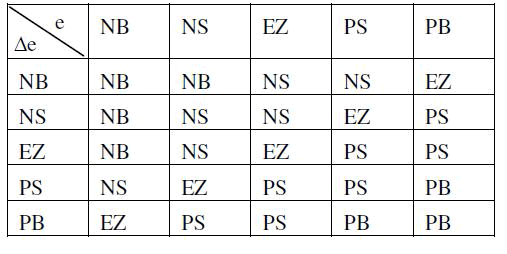 |
| The fuzzy sets have been determined as: NL, negative large, NM, negative medium, NS, negative small and ZE, zero, PS, Positive small, PM positive medium, PL, positive large, respectively. |
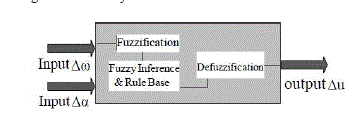 |
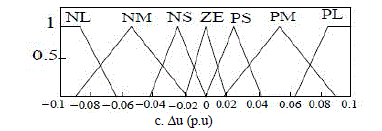 |
| Fig.6 Triangular Membership Functions for Inputs and Output Fuzzy Sets of the Fuzzy Controllers |
SIMULATION AND DISCUSSION |
| A wind power generation system (WECS) based on doubly fed induction generator (DFIG) connected to grid system with fuzzy control system is simulated using MATLAB/SIMULINK software. The frequency is set to 50Hz. The dc link voltage is regulated at 600V. The dc link capacitor is 600μF. |
| In Fig.7 Shows the Simulation diagram of Doubly Fed Induction Generator using the fuzzy logic controller. The proposed control algorithm is applied to a doubly fed induction generator (DFIG) whose stator is directly connected to the grid and the rotor is connected to the grid through a back-to-back AC-DC-AC PWM converters. |
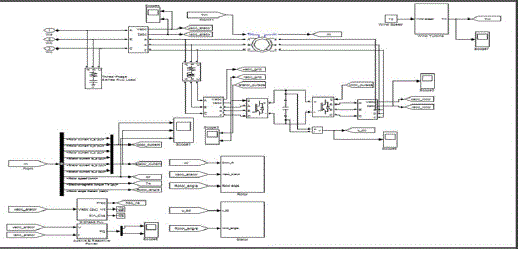 |
| Fig.7 Simulation Diagram of Doubly Fed Induction Generator with Fuzzy Logic Controller |
| In Fig. 8 and 9 Shows simulation diagram of Rotor Side Converter and Grid Side Converter Controller of DFIG system with wind turbine using fuzzy logic controller. This Fuzzy Logic controller is applied to control the rotor side converter (RSC) by using a stator flux oriented strategy and an optimal speed reference which is estimated from the wind speed. The grid side converter is controlled by a PI controller in such a way to guarantee a smooth DC voltage and ensure sinusoidal current in the grid side. |
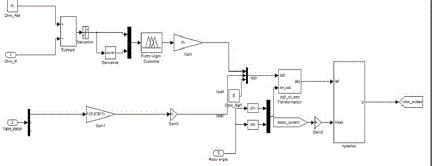 |
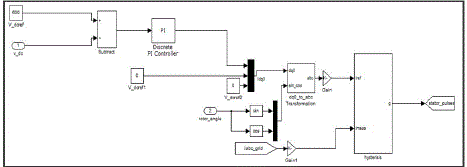 |
CONCLUSION |
| The fuzzy control applied to DFIG is researched, on the basis of which the simulation study is made on DFIG wind generation system. The comparative study is made between PI controller and fuzzy controller in DFIG wind power generation system. The design parameters of PI controller remain to be tested and adjusted in practical, while fuzzy controller has strong robustness to control system whose parameters varied. The results show that fuzzy controller has better performance than PI controller. The simulation results are highly consistent with theoretical analysis and verify correctness of the proposed simulation system. |
References |
|